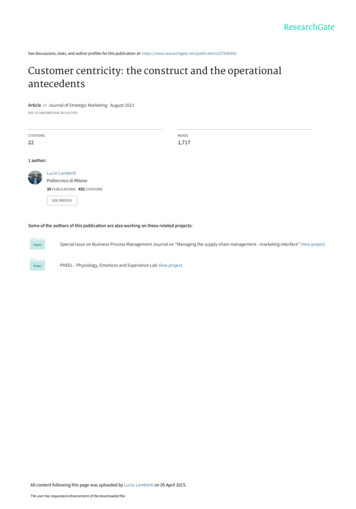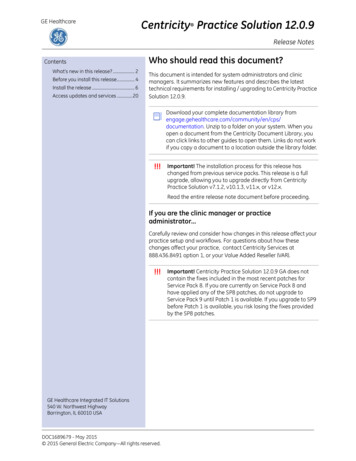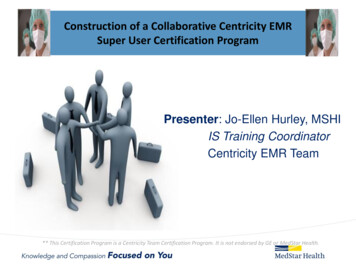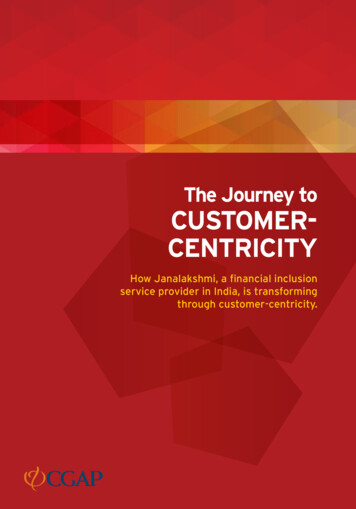
Transcription
See discussions, stats, and author profiles for this publication at: Customer centricity: the construct and the operationalantecedentsArticle in Journal of Strategic Marketing · August 2013DOI: 10.1080/0965254X.2013.817476CITATIONSREADS221,7171 author:Lucio LambertiPolitecnico di Milano39 PUBLICATIONS 492 CITATIONSSEE PROFILESome of the authors of this publication are also working on these related projects:Special Issue on Business Process Management Journal on "Managing the supply chain management - marketing interface" View projectPHEEL - Physiology, Emotions and Experience Lab View projectAll content following this page was uploaded by Lucio Lamberti on 05 April 2015.The user has requested enhancement of the downloaded file.
This article was downloaded by: [Politecnico di Milano Bibl]On: 02 September 2013, At: 03:44Publisher: RoutledgeInforma Ltd Registered in England and Wales Registered Number: 1072954 Registeredoffice: Mortimer House, 37-41 Mortimer Street, London W1T 3JH, UKJournal of Strategic MarketingPublication details, including instructions for authors andsubscription ustomer centricity: the construct andthe operational antecedentsLucio LambertiaaDIG – Department of Management, Economics and IndustrialEngineering , Politecnico di Milano , Milan , ItalyPublished online: 28 Aug 2013.To cite this article: Journal of Strategic Marketing (2013): Customer centricity: the construct andthe operational antecedents, Journal of Strategic Marketing, DOI: 10.1080/0965254X.2013.817476To link to this article: SE SCROLL DOWN FOR ARTICLETaylor & Francis makes every effort to ensure the accuracy of all the information (the“Content”) contained in the publications on our platform. However, Taylor & Francis,our agents, and our licensors make no representations or warranties whatsoever as tothe accuracy, completeness, or suitability for any purpose of the Content. Any opinionsand views expressed in this publication are the opinions and views of the authors,and are not the views of or endorsed by Taylor & Francis. The accuracy of the Contentshould not be relied upon and should be independently verified with primary sourcesof information. Taylor and Francis shall not be liable for any losses, actions, claims,proceedings, demands, costs, expenses, damages, and other liabilities whatsoeveror howsoever caused arising directly or indirectly in connection with, in relation to orarising out of the use of the Content.This article may be used for research, teaching, and private study purposes. Anysubstantial or systematic reproduction, redistribution, reselling, loan, sub-licensing,systematic supply, or distribution in any form to anyone is expressly forbidden. Terms &Conditions of access and use can be found at s
Journal of Strategic Marketing, Customer centricity: the construct and the operational antecedentsLucio Lamberti*DIG – Department of Management, Economics and Industrial Engineering, Politecnico di Milano,Milan, ItalyDownloaded by [Politecnico di Milano Bibl] at 03:44 02 September 2013(Received 21 November 2012; accepted 3 June 2013)Despite the relevant attention paid both by the academic and by the practitionercommunities, extant understanding and knowledge about how to implement customercentricity is substantially scarce. The author draws on the occasional literature oncustomer centricity published over the last years in marketing and other disciplines, andon 43 field interviews with managers (marketers and non-marketers), consultants andacademicians to move toward the establishment of a customer centricity theory. Thiswork identifies and refines the domain of customer centricity, defines customercentricity under an operational viewpoint and provides a comprehensive framework forgrounding further research on the topic, through the deepening of the personal,organizational, inter-organizational and instrumental antecedents of the adoption of acustomer-centric strategy. The work concludes with managerial implicationssuggesting that, despite the enthusiasm around customer centricity, a thoroughanalysis of the contextual factors must be carried out to understand whether to becustomer-centric or not. Further, some organizational and supply-chain implicationsare discussed.Keywords: customer centricity; customer-centric marketing; literature review;construct definition; organizational antecedents; field studyIt is not uncommon for new constructs to be introduced to the [marketing] field withoutoffering precise definitions, without clearly articulating the conceptual distinction betweennewly proposed constructs and related constructs already in vogue in the literature.(Varadarajan, 2010, p. 138)1.IntroductionAmong the newly emerged marketing concepts over the last few years, customer centricityis one of the most debated. Companies like IBM, JetBlue Airways and Best Buy haverecently placed customer centricity at the core of their pursuit of a competitive advantage.Some of the most important consulting groups worldwide like Forrester, BCG andMcKinsey are emphasizing the need for companies to assume a customer-centric approachin response to environmental turbulence and global competition. Some 800,000 web pagestalking about customer centricity may be retrieved on the web. In time, scholars frommarketing (e.g. Syam, Ruan, & Hess, 2005; Tersine & Harvey, 1998), organization (e.g.Anderson, 2005; Galbraith, 2002; Kim, 2007), IT management (e.g. Stefanou,Sarmaniotis, & Stafyla, 2003; Wagner & Majchrzak, 2007) and innovation management*Email: lucio.lamberti@polimi.itq 2013 Taylor & Francis
Downloaded by [Politecnico di Milano Bibl] at 03:44 02 September 20132L. Lamberti(e.g. Selden & MacMillan, 2006), have referred to customer centricity as an incumbentwhen not ineluctable challenge for companies.Despite the enthusiasm on the theme, though, even a cursory review of the literaturewill reveal how neither a shared meaning of the locution ‘customer centricity’, norsufficient indications about what (and why) customer-centric firms do better than noncustomer-centric ones have emerged so far. As a result, it is not clear whether and howcustomer centricity may be beneficial for a company (Gummesson, 2008a), how it ispossible to implement customer centricity, nor if customer centricity should be a must forevery enterprise, or a principle more suited to specific contingencies than to others.Customer centricity currently reflects the situation experienced by the marketingconcept until late 1980s, when the concept was no more than a business philosophy or anideal policy statement (Gummesson, 2008b). Then, the refinement of the marketingconcept implementation, through the analysis of their antecedents and constitutingelements (e.g. Deshpandé & Webster, 1989; Jaworski & Kohli, 1993; Narver & Slater,1990), was the basis for the development of a sound market orientation theory. This is arecursive pattern in theory building: the existence of a ‘paradigm’ setting somecommon traits about a particular topic is a fundamental key for increasing the discipline’sattraction, external interest, attention by researchers from other disciplines and, finally,publications on the topic (Cote et al., 1991). When a concept remains overlyambiguous, insufficiently identified, fluid, changing in time and lacking in clearboundaries, indeed, the literature cannot develop, and theories and literature streams aredestined, at first, to a barren and fragmentary proliferation of viewpoints and, given theabsence of widely accepted interpretation, to a gradual disappearance (Goldman &Grinstein, 2010).Unsurprisingly, looking at previous arguments, the customer centricity literature hasfallen short in comprehensively analyzing the conditions favoring the implementation ofcustomer centricity. Two main contributions may be detected so far in this area, that is,Shah, Rust, Parasuraman, Staelin, and Day (2006) and Sheth, Sisodia, and Sharma (2000).Sheth et al. (2000) analyze the environmental and structural factors (from marketingproductivity issues to market diversity) raising the need for companies to move toward acustomer-centric approach; Shah et al. (2006) stress the areas of intervention (at anorganizational and managerial level) for reaching customer centricity in practice.Nonetheless, they do not address two basic issues about customer centricity, which stillremain substantially uncovered: (1) what customer centricity is and, especially, how it isreally different from established marketing theories, first and foremost market orientation;(2) what are the firm-level antecedents, that is, the characteristics of the firm favoring/hindering the adoption of a customer-centric configuration.The objective of this paper is to provide insight about these two points, movingforward extant knowledge and uncovering areas for future research. To do this, the authorendorses the approach adopted in fundamental studies in the marketing literature (e.g.Kohli & Jaworski, 1990; Lytle, Hom, & Mokwa, 1998): I will match a review of theoccasional and diverse literature on customer centricity with the managerial view of thetopic obtained through a field study. This will help to elicit the cornerstones and possiblecomponents of the customer centricity construct. Having defined the cornerstones of theconcept, then, I will develop a conceptual framework, grounded in diverse marketing andorganizational theories, of the main antecedents favoring/hindering the adoption ofcustomer centricity in practice. This framework will advance a comprehensive overviewof the company-wide conditions for developing customer centricity and will set the framefor empirical research on customer centricity.
Downloaded by [Politecnico di Milano Bibl] at 03:44 02 September 2013Journal of Strategic Marketing3Our hypothesis is that customer centricity, following the scheme previously adoptedwith other strategic orientations (e.g. Kohli & Jaworski, 1990), can actually beimplemented only where some contextual factors are in play at individual (especially forsenior managers), intra-organizational (i.e. related to the relationship amongorganizational units), inter-organizational (as customer centricity is supposed to impacton the overall supply-chain management policies) and infrastructure and system levels.This analysis will lead us to the definition of a proposition inventory to orient futureresearch on the topic, as well as to the elicitation of important issues related to themanagerial domain of the implementation of customer centricity.In the following, a review of the research method adopted will be presented; then, theresults of the literature review and of the field study will be presented to shape theconceptual domain of customer centricity. This will represent the basis for the discussionof the conceptual framework. Finally, the implications of the studies as well as suggestionsfor future research will be proposed.2. Research methodThe first objective of the paper is to advance a conceptual refinement and elicitation of thecustomer centricity concept. To accomplish elicitation, a dynamic juxtaposition ofempirical findings and theoretical contributions is required (Churchill, 1979). Indeed,induction and deduction coexist in theory building, especially as far as the elicitation of ashared concept view from different and contrasting viewpoints is required (Perry, 1998).This is the very case of customer centricity, where theoretical conceptualization is notsufficient to generate a common knowledge among practitioners (e.g. Gummesson,2008a), and purely empirical knowledge is too fluid and relatively poor to lead to univocaltheoretical interpretations. In this perspective, this work combines: (1) a purely theoreticaland deductive approach (systematic literature review) to provide a preliminary field forconceptual refinement; and (2) a purely inductive approach to get the managerialviewpoint on customer centricity avoiding any kind of pre-constituted theoreticalframework, and to develop theory from empirical observations. In the following, themethods adopted for the two studies are detailed.2.1 Literature review2.1.1 Field studyThe field study consisted of in-depth interviews with 43 key informants operating in sevencountries (Australia, China, Germany, Italy, Spain, UK, and USA (see Table 1).Due to ampleness of the customer centricity concept and to the desire to understand itsboundaries, it was important to deal with a wide range of experiences and perspectivesduring data collection. For this reason, a purposive/theoretical sampling plan (Glaser &Strauss, 1967; Kohli & Jaworski, 1990) was used to ensure that the sample includedmarketing and non-marketing professionals, operating in B2B and in B2C markets, inproduct and service markets, and representing all the firm size classes. This samplingmethod has been extensively used in construct development works (e.g. Kohli & Jaworski,1990). We integrated the businessmen perspective with the view of consultants to avoid anexcessive relevance of context-specific knowledge and to uncover possible salient factorsunrevealed by the literature review or by the field study. Out of the 43 interviewees, 17held marketing positions (e.g. marketing managers, brand managers, product managers),14 held non-marketing positions, six were professors in marketing and management and
RoleBusiness Unit ManagerSenior product managerMarketing ManagerPartnerBusiness Developer and Strategic PlannerAssociate Marketing ProfessorMarketing ProfessorMarketingBusiness DevelopmentMarketing DirectorMarketing and Strategy ManagerStrategic PlannerPresidentProduct Marketing ManagerMarketing ManagerInternational ProjectsBrand ManagerProduct ManagerConsultantAssociate Marketing ProfessorStrategic PlannerMarketing ManagerMarketingPartnerBusiness DeveloperGeneral Product ManagerMarketing SpecialistMarketing Steel industryElectric apparelFoodFoodBusiness servicesSemi-conductorsBankingSoftware houseToysWeb onsultancyPharmaceuticalTravel agencyAutomotiveAnimal IPRCUKGERGERUKGERGERIUSACountryVery large (.1000)Medium – large (250 – 500)Medium – large (250 – 500)Not appropriateVery large (.1000)Not appropriateNot appropriateSME (10 –250)Very large (.1000)SME (10 –250)SME (10 –250)Large (500 – 1000)Medium – large (250 – 500)Very large (.1000)Large (500 – 1000)Large (500 – 1000)Medium – large (250 – 500)SME (10 –250)Not appropriateNot appropriateLarge (500 – 1000)SME (10 –250)Very large (.1000)Not appropriateVery large (.1000)Large (500 – 1000)Very large (.1000)Very large (.1000)Company size (no. of employees)Table 1. List of the key informants in the study (AUS ¼ Australia, ES ¼ Spain, I ¼ Italy, GER ¼ Germany, PRC ¼ People’s Republic of China).Downloaded by [Politecnico di Milano Bibl] at 03:44 02 September 20134L. Lamberti
S.S.Z.T.B.PartnerPresidentBusiness DeveloperAssociate Marketing ProfessorMarketing DirectorManagerSenior ConsultantSales ManagerMarketing ProfessorMarketing ProfessorPresidentRegional ManagerTop ManagerMarketing & Communication ManagerWeb Marketing ManagerConsultancyOnline B2C servicesConsumer goodsAcademyConsumer e houseSoftware houseSteel industryWeb auctionsTravel agency (I)ESGERIGERESIUKUKUKUSAGERGERGERIIDownloaded by [Politecnico di Milano Bibl] at 03:44 02 September 2013Not appropriateSME (10 –250)Very large (.1000)Not appropriateLarge (500 – 1000)Not appropriateNot appropriateVery large (.1000)Not appropriateNot appropriateSME (10 –250)Very large (.1000)Medium – large (250 – 500)SME (10 –250)SME (10 –250)Journal of Strategic Marketing5
6L. LambertiDownloaded by [Politecnico di Milano Bibl] at 03:44 02 September 2013six were senior consultants, managers or partners in consulting firms. The following list ofquestions was tackled during each interview, after a brief introduction to the researchproject:1. What does the term ‘customer centricity’ mean to you?2. What does it mean for a company to be customer-centric?3. Describe one (or more) situation in which your company (or a company you haveworked for/with) has been particularly customer-centric.4. Describe one (or more) situation in which your company (or a company you haveworked for/with) has been particularly far from being customer-centric.5. What are the main traits of a customer-centric company? Which activities does acustomer-centric company do differently from the others?6. What has a company to improve in order to achieve a higher level of customercentricity?7. Can you think of business situations in which customer centricity is not soimportant or desirable?8. What factors (may) favor/hinder your company from being customer-centric?The interviews lasted about 45 minutes on average and were all conducted in the interviewee’smother tongue thanks to the collaboration with mother tongue academicians collaborating atthe research project (except for interviews in Italian, Spanish and English, which wereconducted autonomously by the author). The outcomes of the interviews were transcribed andsent back to the interviewee for approval. Interviewees were particularly encouraged toprovide anecdotal memories about the topics and operational insights into the topic.Data and information gathered through the interviews were manipulated before beinganalyzed. In particular, content analysis was applied (Carlson, Grove, & Kangun, 1993;Goulding, 2005): the coding process was undertaken by two coders with a solid marketing/management background and experience in content analysis under the supervision of twoacademicians. To enhance the reliability of the analysis, written guidelines for coding wereprepared (e.g. Leonidou & Leonidou, 2011). Explanation-building procedures were applied sothat the relationships among activities, ideal statements and actual initiatives discussed in theinterview were identified. These structured procedures for data analysis, as well as the use ofthe semi-structured interview guide, helped enhance the reliability of the research (Yin, 2003).Interviews highlighted a copious amount of new insights into the topic; for synthesis itwas necessary to focus on the more ‘interesting’ ones (Kohli & Jaworski, 1990; Zaltman,LeMasters, & Heffring, 1982), where ‘interesting’ means those with the highest potentialin terms of stimulus for future research.3. Customer centricity: the constructCustomer centricity is a very fluid and ambiguous topic. Several papers have talked aboutcustomer centricity over the last 20 years under different perspectives: (1) descriptiveworks on customer centricity practices (e.g. Anderson, 2005; Wagner & Majchrzak,2007); (2) dissertations eulogizing or harshly criticizing the impacts of customer centricityon business performance (e.g. Gummesson, 2008a, 2008b; Kumar & Petersen, 2005;Lenkold, 2004); (3) pre-eminently theoretical works on the contextual factors facilitatingthe implementation of customer centricity (e.g. Sheth et al., 2000; Wind & Rangaswamy,2001); (4) theoretical works on the levers to accomplish customer centricity in a firm (e.g.Galbraith, 2002, 2005; Shah et al., 2006).
Downloaded by [Politecnico di Milano Bibl] at 03:44 02 September 2013Journal of Strategic Marketing73.1 Comparing literature and field perspectivesThe conceptualizations of customer centricity in the literature generally endorse theidea of customer centricity as the opposite of product centricity (e.g. Galbraith, 2005;Shah et al., 2006). The underlying assumption of a product-centric approach sees thecompany as a repository of resources and competences developing products or services.These products and services are the core value proposition, and the company acts on themto please as many customers as possible, modifying the offer to meet customers’expectations (Galbraith, 2002). Customer centricity focuses its attention on the purchaserand on the establishment of mutually satisfactory customer relationships (Day, 2003):individual customers express needs and the company’s resources are activated to developsolutions able to satisfy these needs.Recently, criticism about the actual sustainability of a purely customer-centricapproach has emerged (e.g. Gummesson, 2008a), suggesting that less extreme views,where customer centricity is balanced by a resource focus, may be more economicallyeffective. Although a shared view is missing on this point, it can be hence hypothesizedthat, as customer centricity principles may be adopted also just in part by firms(Gummesson, 2008b), firms operate in a continuum that moves from product centricityto customer centricity.In the literature, customer centricity has been associated with the capability by thecompany to: (1) generate customer intelligence, gathering and processing data andinformation to build comprehensive data repositories about the interactions between thecustomer and the firm, to support customized marketing activities (in the following,customer intelligence generation) (e.g. Sharma & Sheth, 2004; Wind & Rangaswamy,2001); (2) actively involve customers in marketing and innovation processes, cocreating value with them (in the following co-creation) (e.g. Payne & Frow, 2005;Payne, Storbacka, & Frow, 2008); (3) move the focus from the product/service offered tothe whole customer experience to create value in a way that is intimately related to theindividual self of the customer (in the following, experience marketing) (e.g. Perry,2004).This view provided by the literature is quite consistent with the view provided by theinterviewees, though some significant differences have emerged, and, remarkably,practitioners have provided a more operational view of the concept. Such a view refinesthe construct’s domain, moving toward a more operational definition of the construct,facilitating future construct measurement, and eventually theory testing.In the following discussion, we first contrast the field-based view of customercentricity with the literature view on the three commonly accepted pillars – customerintelligence generation, co-creation and experience marketing – and then elaborate on theelements of the field-based view of the construct.3.1.1Customer intelligence generationAll the interviewees emphasized that customer centricity requires a deep knowledge ofcustomers. The idea, received from the literature, of customer database centrality (e.g.Syam et al., 2005) was generally confirmed, but interviewees pointed out a theoreticallyunderdeveloped idea: the dialogical nature of intelligence generation in customercentricity. Customer intelligence generation, in fact, was associated with the ability toestablish a dialogue with customers, aimed at revealing individual customers’ hidden orunconscious needs that ‘even the sharpest market survey will never be able to uncover’(Regional Manager – Software House). Interviewees underline that customer centricity
8L. Lambertiis inherently interaction- and relationship-based. Unsurprisingly, the views on the actualfeasibility of such an approach vary from market to market: while executives operatingin B2B contexts generally consider a personalized approach to CRM in practicesubstantially feasible, B2C executives see customer centricity more as an ideal goal,hardly accomplishable in practice due to the poor concentration of the demand. As anautomotive marketing manager notes: ‘though the objective to satisfy individuals’ needsis our goal, our marketing initiatives must be interesting for a sufficient number ofprospects to be profitable’.Downloaded by [Politecnico di Milano Bibl] at 03:44 02 September 20133.1.2Co-creationThough the term ‘co-creation’ has emerged mostly in the interviews with academiciansand consultants, interviewees generally shared the idea of customer active involvement invalue generation as a main trait of customer centricity. Customer involvement is perceivedas one of the most impacting moments for establishing the dialogue with customers. Theview provided by executives often goes beyond the mere participation in NPD,encompassing a participative approach in marketing decision making. For instance, theMarketing Director of a consumer goods company noted:we have launched a contest in 2009 asking our customers to propose concepts and ideas for themarketing campaign of our top product . . . we received more than 50 videos and ourcommunity voted the best one, which, refined, became our TV commercial for the followingcampaign . . . To me, customer centricity means not only providing customers with what theyneed, but also in the way they want it.The idea of leveraging on user-generated content for developing more customer-focusedmarketing activities has been widely recognized as a way to improve the firm’s customercentricity by executives. Hence co-creation, in practice, emerges as an integration or cooptation (Prahalad & Ramaswamy, 2004) of customer competences in the firm’sinnovation and marketing processes.3.1.3 Experience marketingThe idea of customer experience management, as defined for instance by Schmidt(2003), has generally been neglected by executives. They generally used the term‘solution’ to identify the object of exchange with the customer in a customer-centricperspective, consistently to Galbraith’s (2005) view in the literature. Solution, from caseto case, varied from a combination of product and services to a more complex interactionwhere products and services are provided as a means to satisfy functional and relationalneeds. For instance, an automotive strategic planner argued that being customer-centricin his company meant understanding ‘every single frustration a customer mayexperience during the relationship with the company, from the moment in which thecustomer enters the showroom looking for information to the moment [he/she] decidesto sell the car to buy a new one’ and making all the people interacting with the customerbehave with the objective of preventing such frustration. This viewpoint epitomizes thecommon perception about customer centricity as a firm-level, and not only a marketingrelated, approach. In fact, the implementation of customer centricity has been associatedwith the ability to coordinate marketing and non-marketing activities toward thesatisfaction of customer requirements, including also his/her emotional, social andethical-self (e.g. Lamberti & Lettieri, 2011; Lamberti & Noci, 2012) and also to orientthe whole supply-chain toward this objective. For instance, a Marketing Director in the
Journal of Strategic Marketing9electrical equipment industry highlighted: ‘information sharing along the supply-chainis the key for providing customers with customized and precise solutions: improvingdelivery time, introducing components better fitting their needs, radically improving theunderlying technology of the product’, while a Senior Product Manager of a PublishingCompany noted:Downloaded by [Politecnico di Milano Bibl] at 03:44 02 September 2013customer-centric companies don’t need a particular organizational arrangement. The mostimportant thing is the organizational culture: everyone in the company should have the goal ofgiving to every customer the quickest and most complete answer to his questions and requests. . . It is necessary to adopt the most appropriate organizational structure to provide the rightcustomer answers, but this is nothing without the development of a proper culture.Finally, the idea of customer centricity as experience marketing does not find significantsupport in field interviews. Yet, the view provided by interviews confirms that customercentricity implies attention along all the customer touch-points with the firms and requirescoordination both within the firm and with the whole supply-chain.3.2 Conceptualizing customer centricityThe meaning of customer centricity surfaced in the interviews provides a more operationalview of its constituting elements, suggesting that customer-centric firms manifest: (1) acontinuous interaction with customers aimed at generating intelligence and at understandingcustomer explicit and hidden needs (in the following: interactive customer relationshipmanagement); (2) a systematic involvement of customers in marketing and NPD decisionmaking (in the following: customer integration); (3) strongly coordinated organizationalstructures, gathering and sharing information about the customer and responsively andmanaging the interface all along the touch-points (in the following: internal integration)and; (4) the presence of a supply-chain coordinated with the firm and able to face thecustomization required by customers (in the following: external integration).The nature of the field study, aimed at asking executives how customer-centric firmsbehave, depicts a direction of causality from customer centricity to the manifestations(customer integration; interactive CRM; internal integration; supply-chain integration).Hence, following Jarvis and colleagues’ arguments (2003), customer centricity can behypothesized as a reflective construct with four dimensions of manifestation (Figure 1).Figure 1. The customer centricity construct as emerged from the literature and the field study.
10L. LambertiThus, a customer-centric firm is a firm where these four dimensions are operationallymanifest. Accepting the reflective nature of the construct implies hypothesizing that thefour dimensions should be highly correlat
customer centricity in practice. This framework will advance a comprehensive overview of the company-wide conditions for developing customer centricity and will set the frame for empirical research on customer centricity. 2 L. Lamberti Downloaded by [Politecnico di Milano Bibl] at 03:44 02 September 2013










